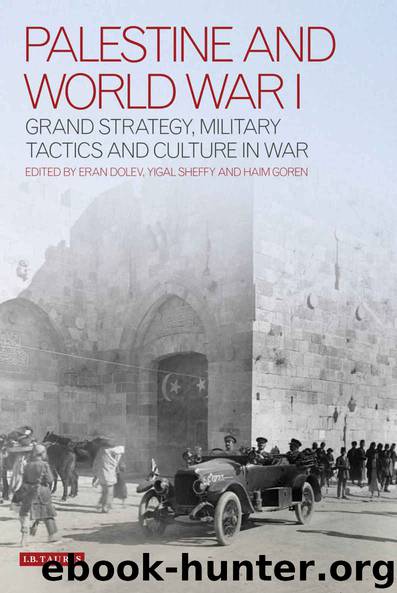Palestine and World War I: Grand Strategy, Military Tactics and Culture in War by Eran Dolev Yigal Sheffy & Haim Goren

Author:Eran Dolev, Yigal Sheffy & Haim Goren
Language: eng
Format: epub
ISBN: 9780857738875
Publisher: I.B.Tauris
Published: 2014-10-16T21:00:00+00:00
Unfortunately, we do not know the name of the other draughtsman. What we do know is that they worked directly under Maule, who seems to have overseen the production process.
There is a little confusion over terminology. What is referred to here as ‘position’ maps are sometimes called ‘operations’ maps (this how they are referred to in the war diary). When class WO 303 was transferred to the National Archives in 1989, the listing referred to the 1:10,000, 1:20,000 and 1:40,000 scale maps as ‘Operations [trench] maps’. Meinertzhagen refers to the maps as showing ‘enemy dispositions’, whereas the printed sheets available in the National Archives show both Turkish and Allied positions (or dispositions).
Meinertzhagen certainly thought that these maps were important, but were they a sufficiently novel innovation to put alongside the pioneering use of air photography for map-making? While the absence of evidence should never be taken as evidence of absence, it does seem that Meinertzhagen's maps were novel. A trawl through the General Staff copies of maps from major battles on the Western Front has revealed nothing quite like the maps produced during the Third Battle of Gaza. In part, that may be a reflection of the almost static nature of the warfare on the Western Front, which meant that rather more simplified maps showing the front line and the frontages of the troops facing British forces was all that was required. The style of maps produced by Meinertzhagen would, however, have been familiar to any officer who had been trained using maps of past battles. Meinertzhagen's innovation was to apply the same style of mapping to an ongoing operation, and produce updates on at least a daily basis.
What the maps can offer is an insight into the sources of intelligence available during the course of the operations. The initial maps show Turkish dispositions in or near the front line, plus some reserve units. This information could have been collected from prisoner interrogations, supplemented by radio interception and aerial reconnaissance. At later dates the maps indicate the presence of units behind the frontline where human intelligence is unlikely to have been a source. The positive identification of units implies that signals intelligence must have been a source (see, for example, the Turkish 20th Division on the map for 8 November 1917). In addition, some maps indicate that Turkish units are in theatre, but at unknown locations (see the note about the 53rd Turkish Division on the map for 18 November). This intelligence was also likely to have been derived from radio interception. A detailed analysis of the maps, in conjunction with the surviving intelligence files, may yield a better picture of the relative inputs from the different intelligence sources.
Download
This site does not store any files on its server. We only index and link to content provided by other sites. Please contact the content providers to delete copyright contents if any and email us, we'll remove relevant links or contents immediately.
| Africa | Americas |
| Arctic & Antarctica | Asia |
| Australia & Oceania | Europe |
| Middle East | Russia |
| United States | World |
| Ancient Civilizations | Military |
| Historical Study & Educational Resources |
Empire of the Sikhs by Patwant Singh(22763)
The Wind in My Hair by Masih Alinejad(4839)
The Templars by Dan Jones(4557)
Rise and Kill First by Ronen Bergman(4545)
The Rape of Nanking by Iris Chang(4022)
12 Strong by Doug Stanton(3419)
Blood and Sand by Alex Von Tunzelmann(3055)
The History of Jihad: From Muhammad to ISIS by Spencer Robert(2504)
Babylon's Ark by Lawrence Anthony(2429)
The Turkish Psychedelic Explosion by Daniel Spicer(2245)
No Room for Small Dreams by Shimon Peres(2235)
Gideon's Spies: The Secret History of the Mossad by Gordon Thomas(2233)
Inside the Middle East by Avi Melamed(2230)
Arabs by Eugene Rogan(2193)
The First Muslim The Story of Muhammad by Lesley Hazleton(2154)
Bus on Jaffa Road by Mike Kelly(2035)
Come, Tell Me How You Live by Mallowan Agatha Christie(2025)
Kabul 1841-42: Battle Story by Edmund Yorke(1921)
1453 by Roger Crowley(1880)
